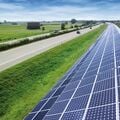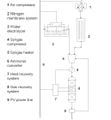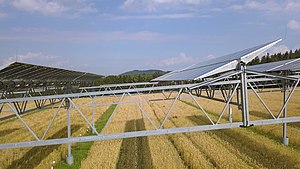
Agrivoltaics or agrophotovoltaics means co-developing the same area of land for both solar photovoltaic power and agricultural production.[1] The coexistence of solar panels and crops implies a sharing of solar radiation between these two types of production.[2] It can be defined as the practice of integrating solar photovoltaics with agricultural practices, for siting photovoltaic production systems on or adjacent to cropland or grazing land. It implies the symbiotic co-production of both agricultural goods and solar energy, with the intent of optimizing the combined outputs. An Ontario company calls Agrivoltaics "a perfect combination of solar panels and plants on farmland... to generate crops and energy simultaneously and without conflict." Agrivoltaics can be thought of as the scientifically planned companion planting of solar energy production and agricultural production.
This page introduces the topic and is intended to help users to find specific content based on geographic focus, climate type, crop or animal production type, and other factors.
- By geography: China, Japan, Japan, Japan, Netherlands, Ontario, Philippines, Thailand [Add more in alphabetical order, please.]
- By crop type -- animals, plants
- Animal grazing [Add more in alphabetical Order, please.
- Berries:
- Fruit Orchards:
- Plants:
- Wheat:
- Fruit
- Vegetables
- Cultivar
- Other specialty agrivoltaic opportunities, linked to research and case studies: greenhouses, aquaculture, hydroponics
Where does agrivoltaics fit within the context of the United Nations Sustainable Development Goals?
Where does agrivoltaics fit within the context of the Pattern Language for a Conservation Economy and Reliable Prosperity?
Related pages on Appropedia[edit | edit source]

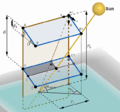


Scholarly literature about Agrivoltaics in General[edit | edit source]
- Al Mamun, Mohammad Abdullah, Paul Dargusch, et al., 2022, "A review of research on agrivoltaic systems," Renewable and Sustainable Energy Reviews, Volume 161, ISSN 1364-0321, https://doi.org/10.1016/j.rser.2022.112351.
- Barron-Gafford, G.A., Pavao-Zuckerman, M.A., Minor, R.L. et al. Agrivoltaics provide mutual benefits across the food–energy–water nexus in drylands. Nat Sustain 2, 848–855 (2019). https://doi.org/10.1038/s41893-019-0364-5
- Harshavardhan Dinesh, and Joshua M. Pearce, "The potential of agrivoltaic systems," Renewable and Sustainable Energy Reviews, 54, 299-308 (2016). DOI:10.1016/j.rser.2015.10.024, open access
- Majumdar, Debaleena, and Martin J. Pasqualetti, "Dual use of agricultural land: Introducing 'agrivoltaics' in Phoenix Metropolitan Statistical Area, USA," Landscape and Urban Planning 170 (2018), 150-168, https://doi.org/10.1016/j.landurbplan.2017.10.011 Open access
- Pascaris, Alexis S., Chelsea Schelly, Laurie Burnham, and Joshua M. Pearce. "Integrating solar energy with agriculture: Industry perspectives on the market, community, and socio-political dimensions of agrivoltaics," Energy Research & Social Science 75(2021), 102023. https://doi.org/10.1016/j.erss.2021.102023, open access
- Pascaris, Alexis S., Chelsea Schelly, and Joshua M. Pearce, "A First Investigation of Agriculture Sector Perspectives on the Opportunities and Barriers for Agrivoltaics," Agronomy 10(2020), n12: 1885. https://doi.org/10.3390/agronomy10121885, Open access
- Pearce, Joshua, Agrivoltaics in Ontario Canada: Promise and Policy, December 2021, University of Western Ontario, PrePrints 2021, DOI:10.20944/preprints202112.0430.v1
- ScienceDirect search for more: https://www.sciencedirect.com/search?qs=Agrivoltaics
- Pearce, J. M. (2022). Agrivoltaics in Ontario Canada: Promise and Policy. Sustainability, 14(5), 3037.
- Pearce, J. M. (2021). Parametric Open Source Cold-Frame Agrivoltaic Systems. Inventions, 6(4), 71.
- Uzair Jamil, Thomas Hickey, and Joshua M. Pearce, 2024, "Solar energy modelling and proposed crops for different types of agrivoltaics systems," Energy Volume 304, 132074, ISSN 0360-5442, https://doi.org/10.1016/j.energy.2024.132074.
Scholarly literature about Agrivoltaics for Specific Crops and Animals[edit | edit source]
- Grapes: Prannay R. Malu, Utkarsh S. Sharma, and Joshua M. Pearce, "Agrivoltaic potential on grape farms in India," Sustainable Energy Technologies and Assessments 23(2017), 104-110. https://doi.org/10.1016/j.seta.2017.08.004.
- Rabbits:
- Alexis Pascaris, Rob Handler, Chelsea Schelly, and Joshua M Pearce, Life cycle assessment of pasture-based agrivoltaic systems: Emissions and energy use of integrated rabbit production, December 2021, https://www.sciencedirect.com/science/article/pii/S2666784321000243?via%3Dihub. Open access.
- William Lytle, Theresa K. Meyer, et al., "Conceptual Design and Rationale for a New Agrivoltaics Concept: Pasture-Raised Rabbits and Solar Farming," Journal of Cleaner Production, 282(2021), 124476, https://doi.org/10.1016/j.jclepro.2020.124476, Open access
- Sheep: Kochendoerfer, Nikola, and Michael L. Thonney, Grazing Sheep on Solar Sites in New York State: Opportunities and Challenges Scope and scaling-up of the NYS sheep industry to graze ground-mounted photovoltaic arrays for vegetation management. Department of Animal Science, Cornell University, February 2021. https://cpb-us-e1.wpmucdn.com/blogs.cornell.edu/dist/c/9310/files/2021/02/Solar-Site-Sheep-Grazing-in-NY.pdf
- Pepper, Corn & Winter Wheat: Pearce, J. M. (2022). Agrivoltaics in Ontario Canada: Promise and Policy. Sustainability, 14(5), 3037.
- Kiwifruit: Jiang, S., Tang, D., Zhao, L., Liang, C., Cui, N., Gong, D., ... & Peng, Y. (2022). Effects of different photovoltaic shading levels on kiwifruit growth, yield and water productivity under “agrivoltaic” system in Southwest China. Agricultural Water Management, 269, 107675.
- Komatsuna, Mizuna, Kabu, and Spinach: KIRIMURA, M., TAKESHITA, S., MATSUO, M., ZUSHI, K., GEJIMA, Y., HONSHO, C., ... & NISHIOKA, K. (2022). Effects of Agrivoltaics (Photovoltaic Power Generation Facilities on Farmland) on Growing Condition and Yield of Komatsuna, Mizuna, Kabu, and Spinach. Environmental Control in Biology, 60(2), 117-127.
- Lettuce & Silverbeet: Nassar, A., Perez-Wurfl, I., Roemer, C., & Hameiri, Z. Improving Productivity of Cropland through Agrivoltaics.
- Bok Choy: Kumpanalaisatit, M., Setthapun, W., Sintuya, H., & Jansri, S. N. (2022). Efficiency Improvement of Ground-Mounted Solar Power Generation in Agrivoltaic System by Cultivation of Bok Choy (Brassica rapa subsp. chinensis L.) Under the Panels. International Journal of Renewable Energy Development, 11(1).
- Corn: Sekiyama, T., & Nagashima, A. (2019). Solar sharing for both food and clean energy production: performance of agrivoltaic systems for corn, a typical shade-intolerant crop. Environments, 6(6), 65.
- Kale, chard, broccoli, peppers, tomatoes, and spinach: Hudelson, T., & Lieth, J. H. (2021, June). Crop production in partial shade of solar photovoltaic panels on trackers. In AIP Conference Proceedings (Vol. 2361, No. 1, p. 080001). AIP Publishing LLC.
- Potatoes: Gfüllner, L., Muller, O., Meier-Grüll, M., Jedmowski, C., & Berwind, M. Yield Optimization Through Control Strategies in Tracked Agrivoltaic Systems.
- Corn, rice, soybean, adzuki bean, garlic, onion, rye, mixed planting of corn with soybean: Jo, H., Asekova, S., Bayat, M. A., Ali, L., Song, J. T., Ha, Y. S., ... & Lee, J. D. (2022). Comparison of Yield and Yield Components of Several Crops Grown under Agro-Photovoltaic System in Korea. Agriculture, 12(5), 619.
Links[edit | edit source]
- American Farmland Trust: High-Level Guiding Principles for Solar Energy Development
- The Bridge, a periodical published by the U.S. National Academies of Sciences, Engineering, and Medicine (NASEM), publishes articles on engineering research, education, and practice; science and technology policy; and the interface between engineering and technology and society. The Spring 2022 Issue is focused on Smart Agriculture. JUNE 15, 2022 VOLUME 52 ISSUE 2. https://www.nae.edu/276483/Summer-Bridge-on-Smart-Agriculture
- Coalition for Community-Solar Access, Community Solar And Farming Are Proving To Be A Perfect Match, April 2021 by Jean Haggerty.
- With funding from the U.S. Department of Energy, scientists at the National Renewable Energy Laboratory, Argonne National Laboratory, and a growing number of universities are researching solar farm designs.
- NREL: Beneath Solar Panels, the Seeds of Opportunity Sprout
- Article in Ecosystem Services, Volume 47, February 2021, 101227: Modeling the ecosystem services of native vegetation management practices at solar energy facilities
- Article in Nature Sustainability Journal: Techno–ecological synergies of solar energy for global sustainability
- February 2021 Webinar Sponsored by Solar United Neighbors:
- Video recording: https://youtu.be/BRYGY498gsU
- Chat log and registrant list (without contact information): https://bit.ly/2ZS2JRC
- Full paper and presentation slides: https://bit.ly/3ss6AkC
- Wikipedia Definition of Agrivoltaic
- Audiopedia Definition, on YouTube (Audio only), with links to additional videos about Agrivoltaics
- Search for agrivoltaics at U.S. National Renewable Energy Laboratory
- Introduction to Agrivoltaics from University of Arizona
- Introduction to Agrivoltaics from Oregon State University
- Introduction to Agrivoltaics from AgDaily online magazine
Events[edit | edit source]
- Clean Energy Resource Teams (Minnesota), Habitat Friendly Solar Summit, March 9, 2022,
News Media Reports[edit | edit source]
- Heckeroth, Stephen, and Carly Rixham, "Agrivoltaics: Have your kale and eat it, too" [Electronic article], Solar Today, Spring 2021, pp. 6-11. https://ases.org/solartoday/
- Kennedy, Ryan, September 2022, "Agrivoltaics: Co-locating solar and agriculture yields mutual benefits," PV Magazine [electronic article], https://pv-magazine-usa.com/2022/09/08/agrivoltaics-co-locating-solar-and-agriculture-yields-mutual-benefits/
- National Public Radio program, 1A (“One A”), March 2, 2023, 1A Remaking America: Can Solar-Power Help Fix Drought-Ravaged Farmlands? [33 minutes], https://www.npr.org/2023/03/02/1160771088/1a-remaking-america-can-solar-power-help-fix-drought-ravaged-farmlands
- Pickerell, Kelly, "Two-year study on economic and environmental impacts of co-located solar + agriculture now underway," Solar Power World, 4 May 2021, https://www.solarpowerworldonline.com/2021/05/two-year-study-on-economic-and-environmental-impacts-of-co-located-solar-agriculture-now-under-way/
- Prevost, Lisa, "Connecticut solar developers enlist sheep to cut grass and ease tensions [Electronic article], Energy News Network, 3 March 2021. https://energynews.us/2021/03/03/northeast/connecticut-solar-developers-enlist-sheep-to-cut-grass-and-ease-tensions/
See also[edit | edit source]
- Floatovoltaics - Photovoltaics that float on water
- Agrivoltaic potential on grape farms in India
- The potential of agrivoltaic systems
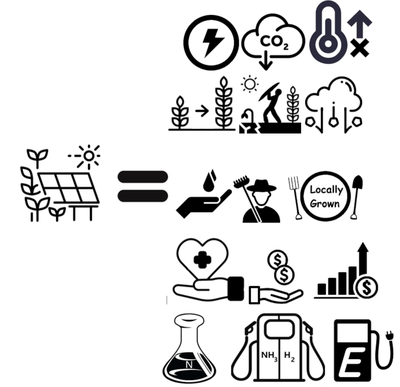
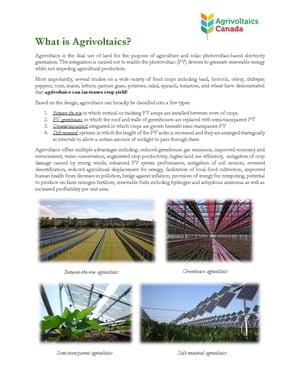
- Coal with Carbon Capture and Sequestration is not as Land Use Efficient as Solar Photovoltaic Technology for Climate Neutral Electricity Production
- Dual use of land for PV farms and agriculture literature review
- sheep
- Israeli white plastic reflectors
- A Farmer's Guide to Going Solar (NREL)
- German guidelines: https://www.ise.fraunhofer.de/content/dam/ise/en/documents/publications/studies/APV-Guideline.pdf
- 2021 review
- Miskin, C.K., Li, Y., Perna, A., Ellis, R.G., Grubbs, E.K., Bermel, P. and Agrawal, R., 2019. Sustainable co-production of food and solar power to relax land-use constraints. Nature Sustainability, 2(10), pp.972-980.
- Retrofitting solar parks for agrivoltaics
- Shading PV
- Alexis' talk at American Solar Grazing Association2021
In the News[edit source]
- Agrivoltaics: solar energy + better crops Climate and Nature
- Why solar power and farmers’ fields could be the perfect combination TVO
- Solar farms and sheep show the makings of a clean energy classic duo Business Renewables
- Agrivoltaics charge up St. Albert-area farms St Albert Gazette
- Sheep, solar and crops. How some Alberta farms are creating ideal growing conditions Western Wheel
- Sheep, solar and crops. How some Alberta farms create ideal growing conditions Voxpopuli
- 3D printed clamps for front-surface PV mounting on wood racking PV Magazine
- Harvesting the Sun to Grow in the Shade Garden Culture Magazine
- What crops fit with vertical agrivoltaics? PV Magazine
- Agrivoltaics – Keeping the farm in the solar farm Green Energy Futures
- Booming solar industry has a growing appetite for weed-chomping crews CBC
- La floreciente industria solar tiene un creciente apetito por equipos de devoradores de maleza Espanol news
- Des cochons à l’ombre des panneaux solaires, l’agrivoltaïsme gagne en popularité Radio Canada
- Pigs in the shade of solar panels, agrivoltaics gains popularity Euro Day France
- Des porcs à l’ombre des panneaux solaires, l’agrivoltaïque gagne en popularité News Day France
- ICI Radio
- The Weather Network
- Agrowoltaika zyskuje na wartości. Panele słoneczne na polu nie przekreślają upraw Business Insider Poland
- Kanada/ Coraz popularniejsza agrowoltaika: rolnictwo i produkcja energii w jednym Deon Pl
- Tu zboże, tam fotowoltaika. Rolnicy produkują i żywność i energię na jednym polu Bankier PL
- Kanada: coraz popularniejsza agrowoltaika: rolnictwo i produkcja energii w jednym MSN PL
- Agrowoltaika podbija świat (Agrovoltaics is conquering the world ) Warzywnichtow Polish
- Coraz popularniejsza agrowoltaika - rolnictwo i produkcja energii w jednym Agro Polska
- Agriculture and Energy Future - Agrivoltaics Agritecture
- MBA students examine a solar farm’s benefits for critical issues case competition Ivey
- Ontario solar curbs rankle expert BNN Bloomberg
References[edit | edit source]
- ↑ Dinesh, Harshavardhan; Pearce, Joshua M. (2016). "The potential of agrivoltaic systems". Renewable and Sustainable Energy Reviews 54: 299–308. doi:10.1016/j.rser.2015.10.024.
- ↑ "A New Vision for Farming: Chickens, Sheep, and ... Solar Panels" (in en). 2020-04-28. Retrieved 2020-07-19.

